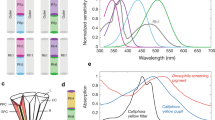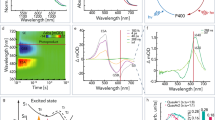Abstract
THE predominant photoreceptor type in flies, R1-6, contains a rhodopsin which absorbs maximally at around 480 nm. Light converts rhodopsin into a thermostable metarhodopsin peaking at around 580 nm (refs. 1–8). A curious discrepancy is the finding that the electrophysiological sensitivity is highest in the UV5,9—completely at variance with known rhodopsin absorption curves. Several possible explanations of the high UV-peak, including the presence of a UV-rhodopsin and waveguide effects, have recently been excluded5–10. Kirschfeld and co-workers have presented an alternative explanation6,11, that R1-6 also contains a photostable pigment that absorbs UV light and converts the photopigment by energy transfer. This hypothesised sensitising pigment would most probably be a carotenoid, since vitamin A deprivation preferentially suppresses UV sensitivity8,12,13. Of course, vitamin A deprivation also lowers sensitivity by reducing the photopigment level14,15. Here we present further evidence for the existence of a vitamin A-dependent non-photopigment substance in fly photoreceptors. We measured fluorescence while simultaneously monitoring photopigment conversions and argue that the fluorescence is probably related to the UV-sensitivity.
This is a preview of subscription content, access via your institution
Access options
Subscribe to this journal
Receive 51 print issues and online access
$199.00 per year
only $3.90 per issue
Buy this article
- Purchase on Springer Link
- Instant access to full article PDF
Prices may be subject to local taxes which are calculated during checkout
Similar content being viewed by others
References
Hamdorf, K., Paulsen, R. & Schwemer, J. in Biochemistry and Physiology of Visual Pigments (ed. Langer, H.) 155–166 (Springer, Berlin, 1973).
Stavenga, D. G., Zantema, A. & Kuiper, J. W. in Biochemistry and Physiology of Visual Pigments (ed. Langer, H.) 175–180 (Springer, Berlin, 1973).
Stavenga, D. G. J. comp. Physiol. 111, 137–152 (1976).
Ostroy, S. E., Wilson, M. & Pak, W. L. Biochem. biophys. Res. Commun. 59, 960–966 (1974).
Stark, W. S., Frayer, K. L. & Johnson, M. A. Biophys. Struct. Mech. 5, 197–209 (1979).
Kirschfeld, K. Biophys. Struct. Mech. 5, 117–128 (1979).
Tsukahara, Y. & Horridge, G. A. J. comp. Physiol. 114, 233–251 (1977).
Stark, W. S., Ivanyshyn, A. M. & Greenberg, R. M. J. comp. Physiol. 121, 289–305 (1977).
Burkhardt, D. Symp. Soc. exp. Biol. 16, 86–109 (1962).
Kirschfeld, K. & Snyder, A. W. Vision Res. 16, 775–778 (1976).
Kirschfeld, K., Franceschini, N. & Minke, B. Nature 269, 386–390 (1977).
Goldsmith, T. H. & Fernandez, H. R. in The Functional Organization of the Compound Eye (ed. Bernhard, C. G.) 125–143 (Pergamon, Oxford, 1966).
Stark, W. S., Ivanyshyn, A. M. & Hu, K. G. Naturwissenschaften 63, 513–518 (1976).
Razmjoo, S. & Hamdorf, K. J. comp. Physiol. 105, 279–286 (1976).
Harris, W. A., Ready, D. F., Lipson, E. D., Hudspeth, A. J. & Stark, W. S. Nature 266, 648–650 (1977).
Franceschini, N. & Kirschfeld, K. Kybernetik 9, 159–182 (1971).
Franceschini, N. in Photoreceptor Optics (eds Snyder, A. W. & Menzel, R.) 98–125 (Springer, Berlin, 1975).
Stavenga, D. G. in Handbook of Sensory Physiology Vol. VII/6A (ed. Autrum, H.) 357–439 (Springer, Berlin, 1979).
Kirschfeld, K. & Franceschini, N. Kybernetik 5, 47–52 (1968).
Harris, W. A., Stark, W. S. & Walker, J. A. J. Physiol., Lond. 256, 415–439 (1976).
Franceschini, N. Neurosci. Lett. Suppl. 1 S, 405 (1978).
Franceschini, N. Proc. int. Un. Physiol. Sci. 13, 237 (1977).
Lo, M.-V. C. & Pak, W. L. Nature 273, 772–774 (1978).
Muijser, H. & Stavenga, D. G. Biophys. Struct. Mech. 5, 187–196 (1979).
Stavenga, D. G. Biophys. Struct. Mech. 5, 175–185 (1979).
Kirschfeld, K., Feiler, R. & Minke, B. Z. Naturforsch. 33 c, 1009–1010 (1978).
Author information
Authors and Affiliations
Rights and permissions
About this article
Cite this article
STARK, W., STAVENGA, D. & KRUIZINGA, B. Fly photoreceptor fluorescence is related to UV sensitivity. Nature 280, 581–583 (1979). https://doi.org/10.1038/280581a0
Received:
Accepted:
Published:
Issue Date:
DOI: https://doi.org/10.1038/280581a0
Comments
By submitting a comment you agree to abide by our Terms and Community Guidelines. If you find something abusive or that does not comply with our terms or guidelines please flag it as inappropriate.



